實戰三個有趣案例,十分鐘入門Canvas
前言
大家好,我是林三心,回想起我當年校招的時候啊,多次被面試官問到canvas,但是我卻不會,后來一直想找個機會學一下canvas,但是一直沒時間。canvas在前端的地位是越來越重要了,為此,我特地寫了3個小項目,讓你們10分鐘就能入門canvas,是的,我的心里沒有她,只有你們
一、canvas實現時鐘轉動
實現以下效果,分為幾步:
1、找到canvas的中心,畫出表心,以及表框
2、獲取當前時間,并根據時間畫出時針,分針,秒針,還有刻度
3、使用定時器,每過一秒獲取新的時間,并重新繪圖,達到時鐘轉動的效果
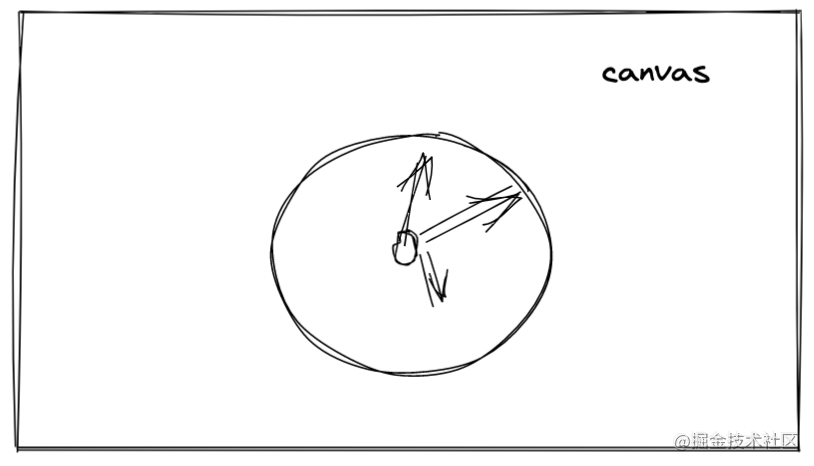 圖片
圖片
1.1 表心,表框
畫表心,表框有兩個知識點:
1、找到canvas的中心位置
2、繪制圓形
//html
<canvas id="canvas" width="600" height="600"></canvas>
// js
// 設置中心點,此時300,300變成了坐標的0,0
ctx.translate(300, 300)
// 畫圓線使用arc(中心點X,中心點Y,半徑,起始角度,結束角度)
ctx.arc(0, 0, 100, 0, 2 * Math.PI)
ctx.arc(0, 0, 5, 0, 2 * Math.PI)
// 執行畫線段的操作stroke
ctx.stroke()讓我們來看看效果,發現了,好像不對啊,我們是想畫兩個獨立的圓線,怎么畫出來的兩個圓連到一起了:
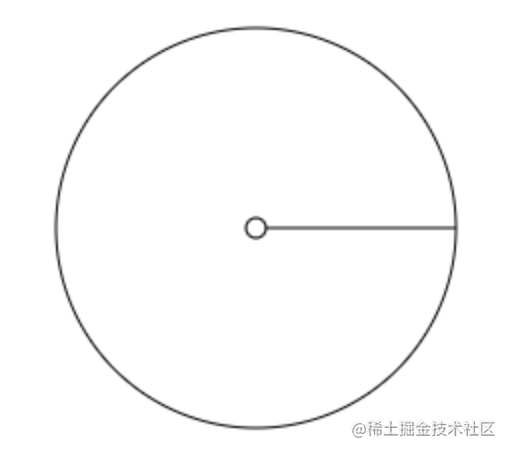 圖片
圖片
原因是:上面代碼畫連個圓時,是連著畫的,所以畫完大圓后,線還沒斬斷,就接著畫小圓,那肯定會大圓小圓連一起,解決辦法就是:beginPath,closePath
ctx.translate(300, 300) // 設置中心點,此時300,300變成了坐標的0,0
// 畫大圓
+ ctx.beginPath()
// 畫圓線使用arc(中心點X,中心點Y,半徑,起始角度,結束角度)
ctx.arc(0, 0, 100, 0, 2 * Math.PI)
ctx.stroke() // 執行畫線段的操作
+ ctx.closePath()
// 畫小圓
+ ctx.beginPath()
ctx.arc(0, 0, 5, 0, 2 * Math.PI)
ctx.stroke()
+ ctx.closePath()1.2 時針,分針,秒針
畫這三個指針,有兩個知識點:
1、根據當前時,分,秒去計算角度
2、在計算好的角度上去畫出時針,分針,秒針 如何根據算好的角度去畫線呢,比如算出當前是3點,那么時針就應該以12點為起始點,順時針旋轉2 * Math.PI / 12 * 3 = 90°,分針和秒針也是同樣的道理,只不過跟時針不同的是比例問題而已,因為時在表上有12份,而分針和秒針都是60份
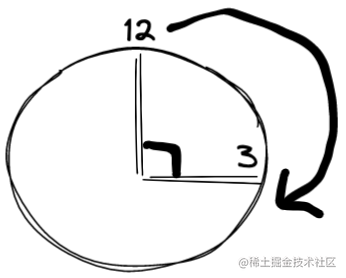 截屏2021-07-19 下午10.07.19.png
截屏2021-07-19 下午10.07.19.png
這時候又有一個新問題,還是以上面的例子為例,我算出了90°,那我們怎么畫出時針呢?我們可以使用moveTo和lineTo去畫線段。至于90°,我們只需要將x軸順時針旋轉90°,然后再畫出這條線段,那就得到了指定角度的指針了。但是上面說了,是要以12點為起始點,我們的默認x軸確是水平的,所以我們時分秒針算出角度后,每次都要減去90°。可能這有點繞,我們通過下面的圖演示一下,還是以上面3點的例子:
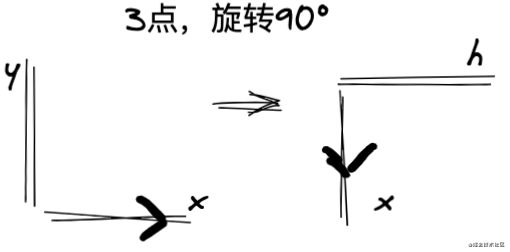 圖片
圖片
截屏2021-07-19 下午10.30.23.png
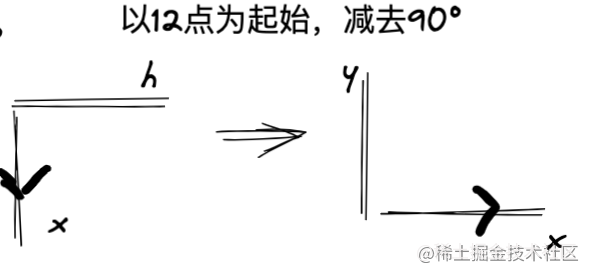 圖片
圖片
這樣就得出了3點指針的畫線角度了。
又又又有新問題了,比如現在我畫完了時針,然后我想畫分針,x軸已經在我畫時針的時候偏轉了,這時候肯定要讓x軸恢復到原來的模樣,我們才能繼續畫分針,否則畫出來的分針是不準的。這時候save和restore就派上用場了,save是把ctx當前的狀態打包壓入棧中,restore是取出棧頂的狀態并賦值給ctx,save可多次,但是restore取狀態的次數必須等于save次數
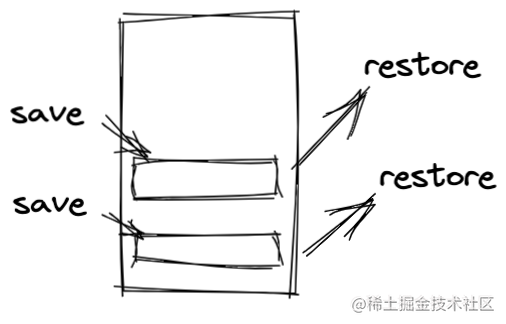 圖片
圖片
截屏2021-07-19 下午10.42.06.png
懂得了上面所說,剩下畫刻度了,起始刻度的道理跟時分秒針道理一樣,只不過刻度是死的,不需要計算,只需要規則畫出60個小刻度,和12個大刻度就行
const canvas = document.getElementById('canvas')
const ctx = canvas.getContext('2d')
ctx.translate(300, 300) // 設置中心點,此時300,300變成了坐標的0,0
// 把狀態保存起來
+ ctx.save()
// 畫大圓
ctx.beginPath()
// 畫圓線使用arc(中心點X,中心點Y,半徑,起始角度,結束角度)
ctx.arc(0, 0, 100, 0, 2 * Math.PI)
ctx.stroke() // 執行畫線段的操作
ctx.closePath()
// 畫小圓
ctx.beginPath()
ctx.arc(0, 0, 5, 0, 2 * Math.PI)
ctx.stroke()
ctx.closePath()
----- 新加代碼 ------
// 獲取當前 時,分,秒
let time = new Date()
let hour = time.getHours() % 12
let min = time.getMinutes()
let sec = time.getSeconds()
// 時針
ctx.rotate(2 * Math.PI / 12 * hour + 2 * Math.PI / 12 * (min / 60) - Math.PI / 2)
ctx.beginPath()
// moveTo設置畫線起點
ctx.moveTo(-10, 0)
// lineTo設置畫線經過點
ctx.lineTo(40, 0)
// 設置線寬
ctx.lineWidth = 10
ctx.stroke()
ctx.closePath()
// 恢復成上一次save的狀態
ctx.restore()
// 恢復完再保存一次
ctx.save()
// 分針
ctx.rotate(2 * Math.PI / 60 * min + 2 * Math.PI / 60 * (sec / 60) - Math.PI / 2)
ctx.beginPath()
ctx.moveTo(-10, 0)
ctx.lineTo(60, 0)
ctx.lineWidth = 5
ctx.strokeStyle = 'blue'
ctx.stroke()
ctx.closePath()
ctx.restore()
ctx.save()
//秒針
ctx.rotate(2 * Math.PI / 60 * sec - - Math.PI / 2)
ctx.beginPath()
ctx.moveTo(-10, 0)
ctx.lineTo(80, 0)
ctx.strokeStyle = 'red'
ctx.stroke()
ctx.closePath()
ctx.restore()
ctx.save()
// 繪制刻度,也是跟繪制時分秒針一樣,只不過刻度是死的
ctx.lineWidth = 1
for (let i = 0; i < 60; i++) {
ctx.rotate(2 * Math.PI / 60)
ctx.beginPath()
ctx.moveTo(90, 0)
ctx.lineTo(100, 0)
// ctx.strokeStyle = 'red'
ctx.stroke()
ctx.closePath()
}
ctx.restore()
ctx.save()
ctx.lineWidth = 5
for (let i = 0; i < 12; i++) {
ctx.rotate(2 * Math.PI / 12)
ctx.beginPath()
ctx.moveTo(85, 0)
ctx.lineTo(100, 0)
ctx.stroke()
ctx.closePath()
}
ctx.restore()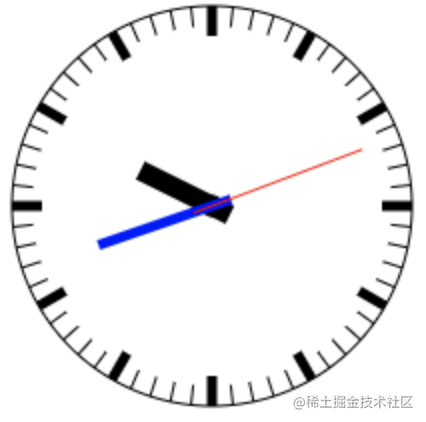 圖片
圖片
最后一步就是更新視圖,使時鐘轉動起來,第一想到的肯定是定時器setInterval,但是注意一個問題:每次更新視圖的時候都要把上一次的畫布清除,再開始畫新的視圖,不然就會出現千手觀音的景象
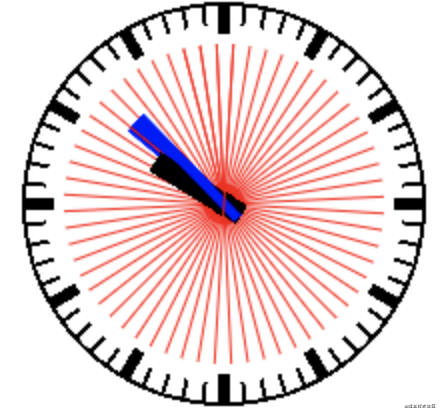 圖片
圖片
附上最終代碼:
const canvas = document.getElementById('canvas')
const ctx = canvas.getContext('2d')
setInterval(() => {
ctx.save()
ctx.clearRect(0, 0, 600, 600)
ctx.translate(300, 300) // 設置中心點,此時300,300變成了坐標的0,0
ctx.save()
// 畫大圓
ctx.beginPath()
// 畫圓線使用arc(中心點X,中心點Y,半徑,起始角度,結束角度)
ctx.arc(0, 0, 100, 0, 2 * Math.PI)
ctx.stroke() // 執行畫線段的操作
ctx.closePath()
// 畫小圓
ctx.beginPath()
ctx.arc(0, 0, 5, 0, 2 * Math.PI)
ctx.stroke()
ctx.closePath()
// 獲取當前 時,分,秒
let time = new Date()
let hour = time.getHours() % 12
let min = time.getMinutes()
let sec = time.getSeconds()
// 時針
ctx.rotate(2 * Math.PI / 12 * hour + 2 * Math.PI / 12 * (min / 60) - Math.PI / 2)
ctx.beginPath()
// moveTo設置畫線起點
ctx.moveTo(-10, 0)
// lineTo設置畫線經過點
ctx.lineTo(40, 0)
// 設置線寬
ctx.lineWidth = 10
ctx.stroke()
ctx.closePath()
ctx.restore()
ctx.save()
// 分針
ctx.rotate(2 * Math.PI / 60 * min + 2 * Math.PI / 60 * (sec / 60) - Math.PI / 2)
ctx.beginPath()
ctx.moveTo(-10, 0)
ctx.lineTo(60, 0)
ctx.lineWidth = 5
ctx.strokeStyle = 'blue'
ctx.stroke()
ctx.closePath()
ctx.restore()
ctx.save()
//秒針
ctx.rotate(2 * Math.PI / 60 * sec - Math.PI / 2)
ctx.beginPath()
ctx.moveTo(-10, 0)
ctx.lineTo(80, 0)
ctx.strokeStyle = 'red'
ctx.stroke()
ctx.closePath()
ctx.restore()
ctx.save()
// 繪制刻度,也是跟繪制時分秒針一樣,只不過刻度是死的
ctx.lineWidth = 1
for (let i = 0; i < 60; i++) {
ctx.rotate(2 * Math.PI / 60)
ctx.beginPath()
ctx.moveTo(90, 0)
ctx.lineTo(100, 0)
// ctx.strokeStyle = 'red'
ctx.stroke()
ctx.closePath()
}
ctx.restore()
ctx.save()
ctx.lineWidth = 5
for (let i = 0; i < 12; i++) {
ctx.rotate(2 * Math.PI / 12)
ctx.beginPath()
ctx.moveTo(85, 0)
ctx.lineTo(100, 0)
// ctx.strokeStyle = 'red'
ctx.stroke()
ctx.closePath()
}
ctx.restore()
ctx.restore()
}, 1000)效果 very good啊:
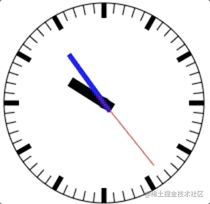 clock的副本
clock的副本
二、canvas實現刮刮卡
小時候很多人都買過充值卡把,懂的都懂啊哈,用指甲刮開這層灰皮,就能看底下的答案了。
 圖片
圖片
思路是這樣的:
1、底下答案是一個div,頂部灰皮是一個canvas,canvas一開始蓋住div
2、鼠標事件,點擊時并移動時,鼠標經過的路徑都畫圓形開路,并且設置globalCompositeOperation為destination-out,使鼠標經過的路徑都變成透明,一透明,自然就顯示出下方的答案信息。
關于fill這個方法,其實是對標stroke的,fill是把圖形填充,stroke只是畫出邊框線
// html
<canvas id="canvas" width="400" height="100"></canvas>
<div class="text">恭喜您獲得100w</div>
<style>
* {
margin: 0;
padding: 0;
}
.text {
position: absolute;
left: 130px;
top: 35px;
z-index: -1;
}
</style>
// js
const canvas = document.getElementById('canvas')
const ctx = canvas.getContext('2d')
// 填充的顏色
ctx.fillStyle = 'darkgray'
// 填充矩形 fillRect(起始X,起始Y,終點X,終點Y)
ctx.fillRect(0, 0, 400, 100)
ctx.fillStyle = '#fff'
// 繪制填充文字
ctx.fillText('刮刮卡', 180, 50)
let isDraw = false
canvas.onmousedown = function () {
isDraw = true
}
canvas.onmousemove = function (e) {
if (!isDraw) return
// 計算鼠標在canvas里的位置
const x = e.pageX - canvas.offsetLeft
const y = e.pageY - canvas.offsetTop
// 設置globalCompositeOperation
ctx.globalCompositeOperation = 'destination-out'
// 畫圓
ctx.arc(x, y, 10, 0, 2 * Math.PI)
// 填充圓形
ctx.fill()
}
canvas.onmouseup = function () {
isDraw = false
}效果如下:
 guaguaka.gif
guaguaka.gif
三、canvas實現畫板和保存
框架:使用vue + elementUI
其實很簡單,難點有以下幾點:
1、鼠標拖拽畫正方形和圓形
2、畫完一個保存畫布,下次再畫的時候疊加
3、保存圖片
第一點,只需要計算出鼠標點擊的點坐標,以及鼠標的當前坐標,就可以計算了,矩形長寬計算:x - beginX, y - beginY,圓形則要利用勾股定理:Math.sqrt((x - beginX) * (x - beginX) + (y - beginY) * (y - beginY))
第二點,則要利用canvas的getImageData和putImageData方法
第三點,思路是將canvas生成圖片鏈接,并賦值給具有下載功能的a標簽,并主動點擊a標簽進行圖片下載
看看效果吧:
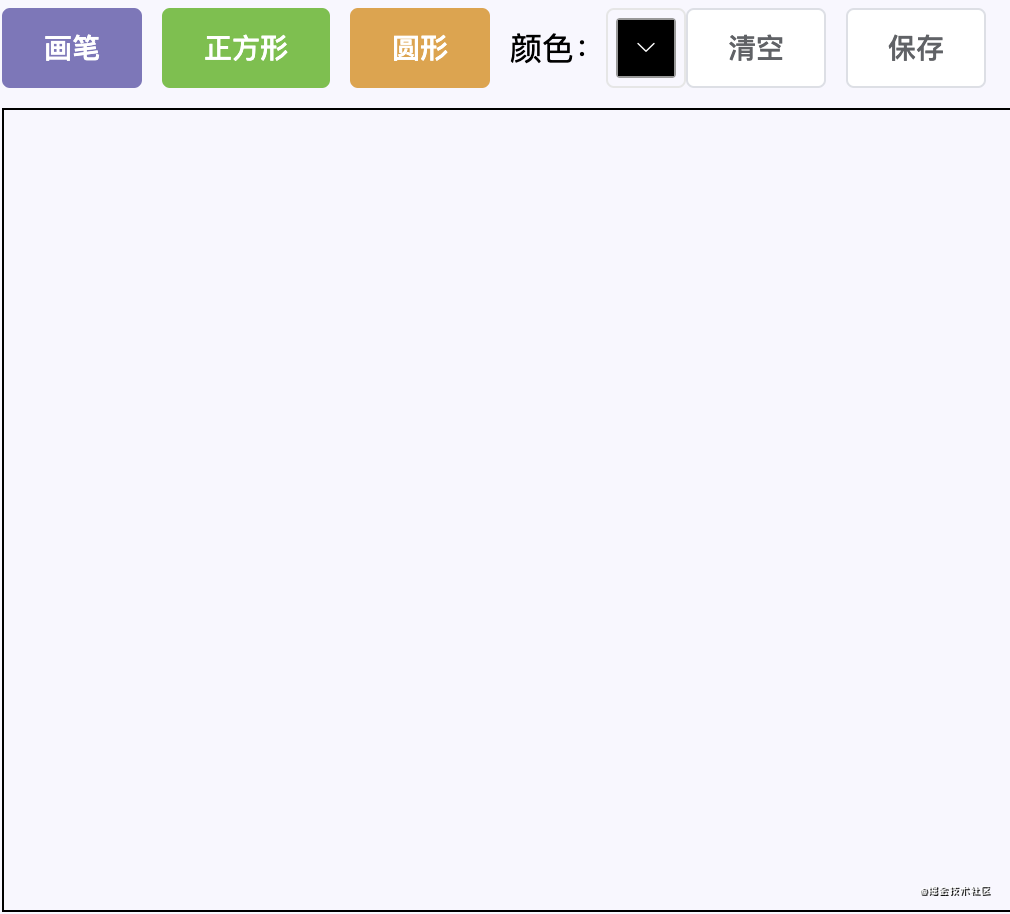 圖片
圖片
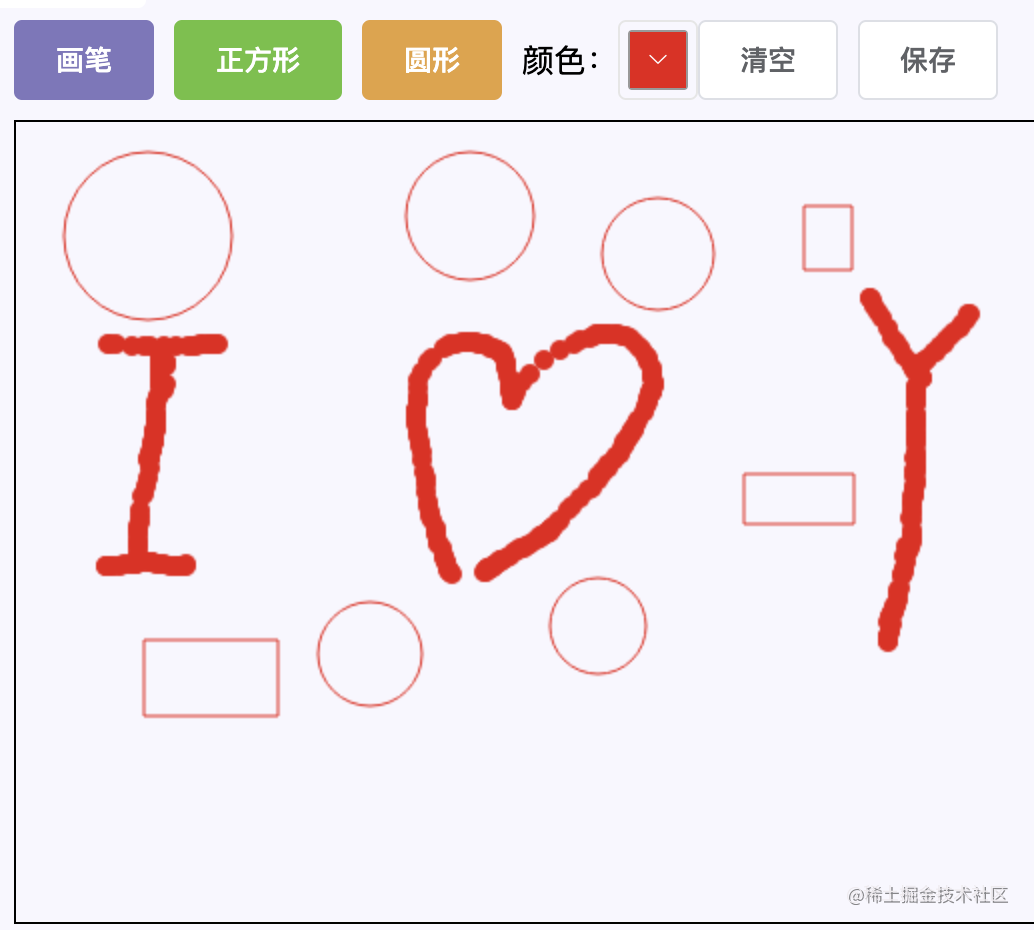 圖片
圖片
具體代碼我就不過多講解了,說難也不難,只要前面兩個項目理解了,這個項目很容易就懂了:
<template>
<div>
<div style="margin-bottom: 10px; display: flex; align-items: center">
<el-button @click="changeType('huabi')" type="primary">畫筆</el-button>
<el-button @click="changeType('rect')" type="success">正方形</el-button>
<el-button
@click="changeType('arc')"
type="warning"
style="margin-right: 10px"
>圓形</el-button
>
<div>顏色:</div>
<el-color-picker v-model="color"></el-color-picker>
<el-button @click="clear">清空</el-button>
<el-button @click="saveImg">保存</el-button>
</div>
<canvas
id="canvas"
width="800"
height="400"
@mousedown="canvasDown"
@mousemove="canvasMove"
@mouseout="canvasUp"
@mouseup="canvasUp"
>
</canvas>
</div>
</template>
<script>
export default {
data() {
return {
type: "huabi",
isDraw: false,
canvasDom: null,
ctx: null,
beginX: 0,
beginY: 0,
color: "#000",
imageData: null,
};
},
mounted() {
this.canvasDom = document.getElementById("canvas");
this.ctx = this.canvasDom.getContext("2d");
},
methods: {
changeType(type) {
this.type = type;
},
canvasDown(e) {
this.isDraw = true;
const canvas = this.canvasDom;
this.beginX = e.pageX - canvas.offsetLeft;
this.beginY = e.pageY - canvas.offsetTop;
},
canvasMove(e) {
if (!this.isDraw) return;
const canvas = this.canvasDom;
const ctx = this.ctx;
const x = e.pageX - canvas.offsetLeft;
const y = e.pageY - canvas.offsetTop;
this[`${this.type}Fn`](ctx, x, y);
},
canvasUp() {
this.imageData = this.ctx.getImageData(0, 0, 800, 400);
this.isDraw = false;
},
huabiFn(ctx, x, y) {
ctx.beginPath();
ctx.arc(x, y, 5, 0, 2 * Math.PI);
ctx.fillStyle = this.color;
ctx.fill();
ctx.closePath();
},
rectFn(ctx, x, y) {
const beginX = this.beginX;
const beginY = this.beginY;
ctx.clearRect(0, 0, 800, 400);
this.imageData && ctx.putImageData(this.imageData, 0, 0, 0, 0, 800, 400);
ctx.beginPath();
ctx.strokeStyle = this.color;
ctx.rect(beginX, beginY, x - beginX, y - beginY);
ctx.stroke();
ctx.closePath();
},
arcFn(ctx, x, y) {
const beginX = this.beginX;
const beginY = this.beginY;
this.isDraw && ctx.clearRect(0, 0, 800, 400);
this.imageData && ctx.putImageData(this.imageData, 0, 0, 0, 0, 800, 400);
ctx.beginPath();
ctx.strokeStyle = this.color;
ctx.arc(
beginX,
beginY,
Math.round(
Math.sqrt((x - beginX) * (x - beginX) + (y - beginY) * (y - beginY))
),
0,
2 * Math.PI
);
ctx.stroke();
ctx.closePath();
},
saveImg() {
const url = this.canvasDom.toDataURL();
const a = document.createElement("a");
a.download = "sunshine";
a.href = url;
document.body.appendChild(a);
a.click();
document.body.removeChild(a);
},
clear() {
this.imageData = null
this.ctx.clearRect(0, 0, 800, 400)
}
},
};
</script>
<style lang="scss" scoped>
#canvas {
border: 1px solid black;
}
</style>




































